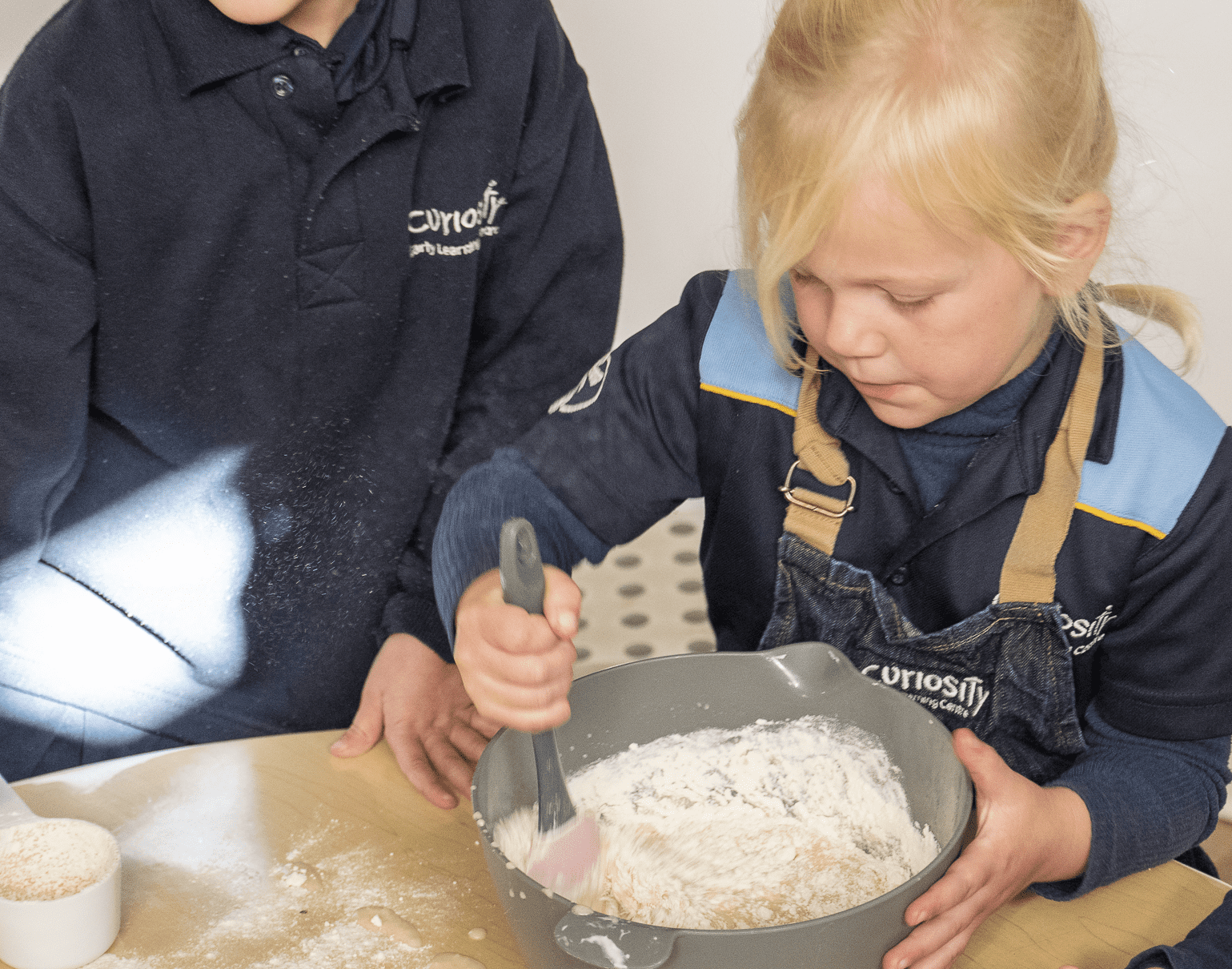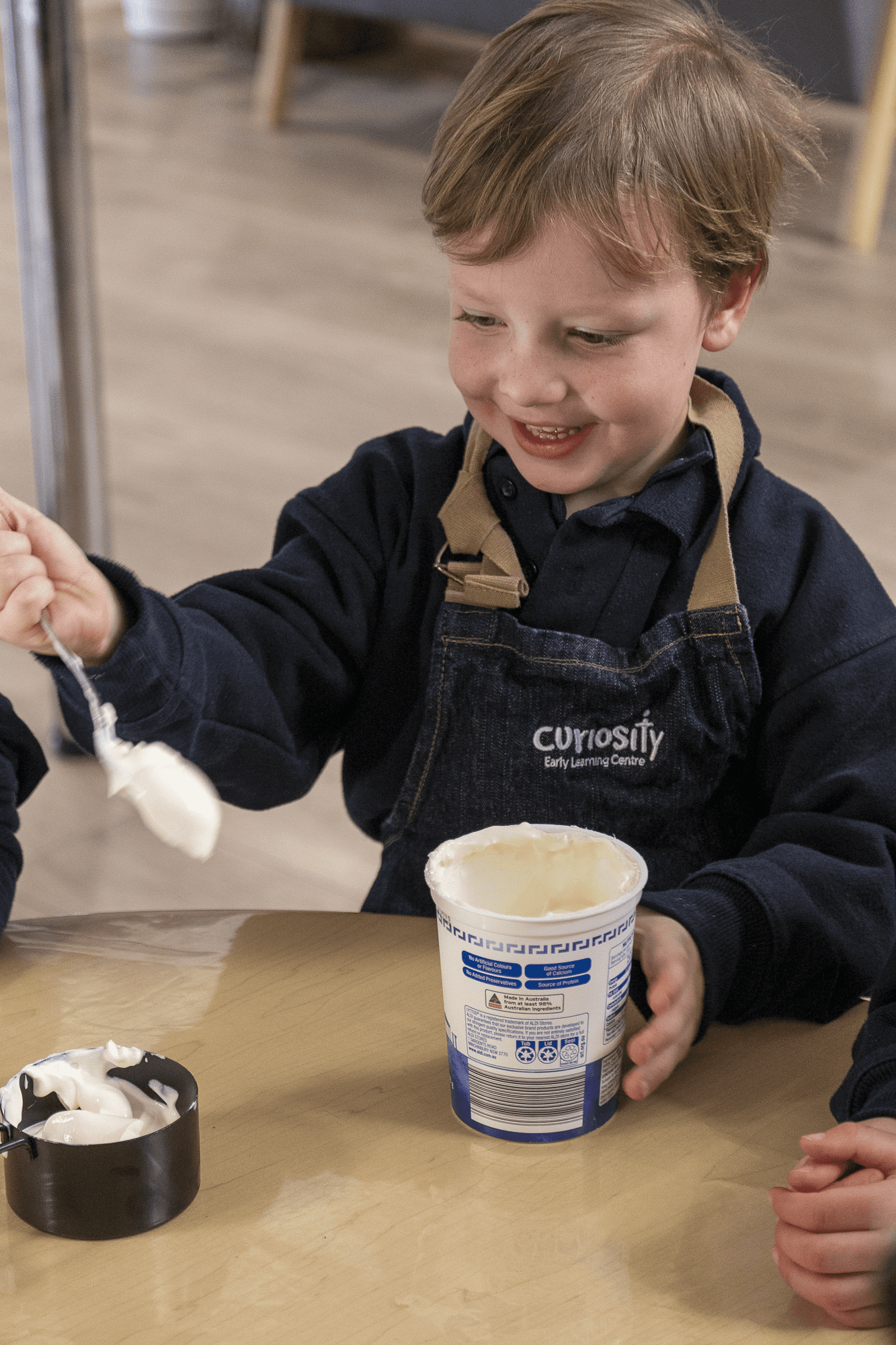Ready, steady, let’s cook! This week our Orange and Blue teams at Curiosity ELC baked a yummy (almost) healthy green cake… can you guess the secret ingredient?
(Just want the yummy recipe? Jump to it!)
Green Vanilla Cake – A Sweet Learning Opportunity

At Curiosity ELC, we are always looking for innovative ways to engage our students and provide hands-on learning experiences. One such activity that always proves to be both enjoyable and educational is teaching our young students how to bake a cake. This simple yet effective learning inquiry offers many important learning outcomes across multiple areas of our curriculum. From mathematics to social skills, the process of baking can be a powerful educational tool.

Cognitive Development: A Recipe for Growth
Baking a cake provides a wealth of learning opportunities for young students, enriching their development across various areas of the curriculum. Cognitively, the activity strengthens mathematical skills as children measure ingredients, understand proportions, and follow sequential steps. It also enhances scientific understanding as they observe changes in matter when mixing and heating ingredients, fostering an early grasp of cause and effect. Reading and comprehension are also improved as students follow written recipes, expanding their vocabulary with culinary terms like “whisk,” “bake,” and “sift.”
Social and Emotional Development: Mixing Up Teamwork and Responsibility
Baking encourages collaboration as students work together, take turns, and share tasks, promoting teamwork and communication. The responsibility of managing individual tasks and cleaning up afterwards teaches accountability. Lots of sharing, negotiating, collaboration, and connecting happens when students bake together. It’s especially fun laughing and learning together when we make mistakes and have another go.
Physical Development
Baking develops fine motor skills through actions like stirring, pouring, and measuring, which require precision and control. Gross motor skills are also practised as students move around the kitchen and coordinate their movements, enhancing physical coordination and dexterity which are crucial for overall development.
Creative Development: Decorating with Imagination
Creativity flourishes in the kitchen. Baking allows for artistic expression as children decorate the cake and experiment with colours and designs. This creative outlet encourages them to make choices and solve problems when things don’t go as planned. Adjusting the recipe or the decoration can turn a potential mishap into an exciting challenge, providing opportunities for growth in resilience and innovative thinking.
Practical Life Skills: Ingredients for Everyday Success
Baking imparts valuable practical life skills. It offers lessons in nutrition and health as children learn about different ingredients and food hygiene. Understanding the role of each ingredient and practising cleanliness in the kitchen are crucial lessons for everyday life. Time management is also practised as students plan the baking process, understand the importance of timing in cooking, and manage their activities effectively.
Baking a cake is more than just a fun activity; it’s a comprehensive learning experience that supports cognitive, social, emotional, physical, and creative development. Young students gain a broad range of skills and knowledge that extend far beyond the kitchen, contributing to a well-rounded early education. So next time you bake a cake with your child, remember you’re not just making a sweet treat—you’re cooking up a batch of essential life skills!

With three cups of spinach for the healthy factor and a tin of apples for sweetness, this Green Vanilla Cake is sure to be a yummy way to get greens into your little ones!
Green Vanilla Cake
Ingredients
- 3 cups raw spinach, blended to make it a smooth paste (we left ours a little chunkier)
- 3/4 cup of plain greek yogurt (If you prefer, swap this for 3 eggs, beaten)
- 2 teaspoons vanilla extract
- 1 tin apple pieces pureed
- If you like your baking a little sweeter, you may also add 3/4 cup caster sugar
- 1/2 cup vegetable oil
- 2 cups self raising flour
- 2 teaspoons baking powder
- 1/2 teaspoon salt
For the Vanilla Frosting
- 75g unsalted butter
- 2 cups powdered icing sugar sifted
- 1 teaspoon vanilla extract
- 1 tablespoon milk
- optional – sprinkles to decorate
Method
- Preheat the oven to 180 degrees. Grease and line a 20cm cake tin.
- Puree the tinned apple and set aside.
- Steam or simmer the spinach for a few minutes until wilted.
- Run under water to refresh, drain and squeeze out any excess moisture. Puree well and set aside.
- Beat the yogurt, oil, vanilla, apple puree and sugar together well. Beat in the spinach puree.
- Sift in the flour, baking powder, and salt and gently stir to combine.
- Pour mixture into the prepared cake tin and bake for 25-30mins until an inserted skewer comes out clean.
- Cool for 5 minutes in the tin then turn onto a wire rack to cool completely.
While waiting for the cake to cool, it’s time to make the vanilla frosting;
- In a large mixing bowl, beat the softened butter with an electric mixer on medium speed until it becomes smooth and creamy.
- Gradually add the sifted powdered icing sugar to the butter, about half a cup at a time, beating well after each addition.
- Add the vanilla extract to the mixture and beat until well combined.
- Add the milk, a little at a time, and beat until the frosting reaches your desired consistency. If the frosting is too thick, add a little more milk. If it’s too thin, add a bit more powdered icing sugar.
- Once the frosting is smooth and fluffy, and the cake is cooled, the frosting is ready to be spread onto your cake.
You wouldn’t think a cake with spinach would taste good, right? Well, this cake will surprise you, ALL our ELC children loved it… Enjoy!
If you give this recipe a try with your kiddos we would love for you to share the results with us on Facebook or Instagram using the hashtag #gspvcreativity





Love this? Why not try our Silverbeet, Pea and Feta Sausage Rolls!
